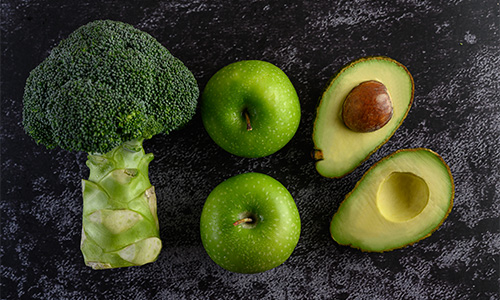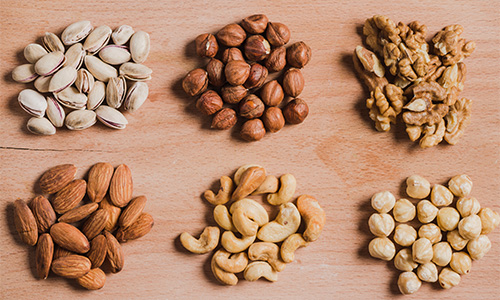The Galveston Diet was created by Dr. Mary Haver, an experienced obstetrician-gynecologist. She developed the Galveston diet meal plan in response to her patients’ concerns about weight gain during menopause.
Haver created the Galveston diet concept when she was attempting to lose weight after her menopause and while grieving over her brother’s death. After struggling by eating less and working out more, she realized the old diet concept of “calories in versus calories out” was not satisfactory. Hence, she invented the Galveston Diet meal plan, which focuses on the nature of the food and the nutrient timings.
What Is the Galveston Diet?

The Galveston diet is a unique weight loss program (or meal plan) invented to help people manage and lose weight effectively during menopause. Instead of reducing the calories, it highlights the significance of the best time to eat, what to eat, and which foods to avoid. The main principle behind the diet is the consumption of anti-inflammatory food and intermittent fasting.
Haver figured out that hormones play a major role in weight management, which is also influenced by the food you eat. Haver says consuming anti-inflammatory foods will aid in the regulation of hormones.
The Galveston diet focuses on whole foods and limits processed foods, artificial foods, and added sugars. Since we are talking about menopause, also read about fighting menopause blues.
How Does the Galveston Diet Work?
Women experience hormonal changes around the time of menopause. These changes, combined with several other factors, result in weight gain. However, the Galveston diet helps middle-aged women lose weight easily. It also helps them lead a healthier lifestyle.
To put it in a nutshell, the Galveston diet is a self-paced program that assists middle-aged women in all the phases of menopause. It is an innovative solution that helps women lose belly fat and regain confidence. Since it is a self-paced program, you will be the one to decide when to start and when to finish it! You will also be provided with fitness tips, delicious recipes, etc.

According to several research studies, inflammation and obesity are related. So, if you consume anti-inflammatory foods like fruits and vegetables, you can easily lose weight. A cut down on inflammatory processed food items and sugar will also assist you in losing weight. While your diet does not play a direct role in the functioning of your hormones, it can certainly help in the balancing of the hormones, resulting in better body functioning and overall health. This is how the diet works!
The Fundamentals of the Galveston Diet
The diet can be categorized into 3 sections, which are described below.
1. Intermittent Fasting

Fasting has been practiced for many years and is also an important custom followed by many religions and customs worldwide. Intermittent fasting involves limiting the intake of calories to a predetermined 8 hours per day. You refrain from eating food for the remaining 16 hours, though you are permitted to drink water and black coffee/tea.
The 16/8 intermittent fasting is believed to control blood sugar levels and enhance longevity. It is preferable to repeat the cycle twice a week.
2. Anti-Inflammatory Nutrition

Why do you need anti-inflammatory nutrition? To know the reason, you must first understand the causes of inflammation in your body.
When a foreign particle like a microbe or plant pollen enters your body, the immune system gets activated, resulting in the process called inflammation, which protects the body from the foreign particle. If your body experiences intermittent bouts of inflammation, which are essential to combat health-threatening foreign particles (that invade the body), there is no problem. However, in some situations, the inflammation becomes chronic. In other words, it gets persistent even during times when there is no invading foreign particle! In such cases, inflammation, by itself, acts as your enemy, leading to diseases like cancer, heart problems, depression, diabetes, and even Alzheimer’s. Therefore, you need some anti-inflammatory foods to minimize inflammation and its effects.
So, it is advisable to lessen the inflammatory foods, such as sweetened drinks, white bread, cookies, crackers, chips, and alcohol. Instead, add anti-inflammatory food items like broccoli, blueberries, avocados, olives, salmon, almonds, bell peppers, dark chocolate, turmeric, and green tea. This is what the Galveston diet advocates.
Have you now understood why the Galveston meal plan focuses on anti-inflammatory nutrition?
3. Fuel Refocus

The Galveston diet ultimately focuses on high-fat and low-carb food preferences. It insists on consuming fats and proteins while decreasing carb intake. It helps you gain 70% of your daily calories from fats, 20% from proteins, and 10% from carbs. The main aim of the diet is to obtain most of the calories from fats, instead of carbs.
Foods to Eat and Avoid in the Galveston Diet
The Galveston food regimen generally encourages excessive fats and low-carb, antioxidant-rich, and anti-inflammatory foods. You can also drink tea and eat fermented ingredients that are rich in probiotics. You must avoid processed meals, sugar, and alcohol.
Now, let’s have a detailed look at the food items you must include in your diet and the ones you should avoid.
Foods to Eat

- Fats: olive oil, coconut oil, MCT oil, butter, ghee, avocado oil, and sesame oil
- Proteins: lean ground beef, chicken, turkey, eggs, lean pork, salmon, trout, tuna, and shellfish
- Fruits: avocado, strawberries, blueberries, and raspberries
- Leafy greens: spinach, kale, lettuce, dill, and mustard greens
- Other vegetables: cauliflower, broccoli, cabbage, tomato, bell pepper, cucumber, onion, and carrots
- Nuts: cashews, pistachios, almonds, and peanuts
- Seeds: pumpkin, sesame, sunflower, flax, and chia seeds
- Dairy: heavy cream, cheese, sour cream, plain Greek yogurt, and nut milk
- Tea: black, green, oolong, and chamomile teas
- Fresh herbs: ginger, garlic, parsley, thyme, and basil
Foods to Avoid

- Sweeteners: added sugar and artificial sweeteners
- Food additives: artificial additives (flavors, colors, and preservatives)
- Alcohol: beer, wine, and spirits
- Processed foods: refined grains, fried foods, and processed meats
- Vegetable oils high in omega-6 fats: soybean, sunflower, safflower, and corn oil
- Sugar-sweetened beverages: sweet tea, colas, soft drinks, and juice
Is the Galveston Diet Good for You?

In the menopausal stage, women are prone to gain more weight, and additionally, they experience several physical and psychological changes. Moreover, menopause leads to abdominal obesity, and increased body weight and size, which increases the risk of cardiovascular disease.
A 3-month study involving 40 people revealed that the 16/8 intermittent fasting helped reduce belly fat and trim the waist by an average size of 2.1 inches. This is why we say that the Galveston diet might be good for you.
However, this diet cannot be followed by all women. The downside is that women with diabetes and those under medication (for a particular disease/disorder) cannot follow the 16/8 intermittent fasting rule. If such a person follows the diet, it can lead to severe health complications. It can result in low sugar among people with diabetes, which is extremely dangerous. Sometimes, very low levels of sugar can even prove fatal.
Because of the disadvantages of the diet, it is not recommended for all women during the different stages of menopause. So, before you start following the diet, consult with your doctor/healthcare provider. This is not only true with the Galveston diet but also with other similar diet programs. Since we are talking about diet programs and weight loss, take a look at the breakfast foods for weight loss, during your leisure time.
Pros & Cons of the Galveston Diet

Now that you have become familiar with the fundamentals of the diet, let’s take some time to analyze its pros and cons.
Pros

- Apart from weight reduction, the diet lowers inflammation.
- Intermittent fasting helps reduce the risk of various diseases, including obesity, insulin resistance, and heart disease.
- Intermittent fasting and a low-carb diet improve blood sugar level management. However, fasting among diabetics could be dangerous, as mentioned earlier.
Cons

- All of us need a balanced diet, including carbohydrates, proteins, fats, vitamins, and minerals. The Galveston diet contains a very low amount of carbohydrates, so, it cannot be followed by all women.
- No clinical proof supports the theory that the Galveston weight-reduction plan helps menopausal women shed pounds, although many women have found it beneficial.
- Just like many diet plans, this diet can cause some side effects in people following it. The 8-hour window of eating will not be sufficient for all women during the various stages of menopause. When you are free, read the study on the influence of meal frequency and timing on health in humans from the National Library of Medicine.
Final Word
Hope you now know the answer to, “What is the Galveston diet?”
You must consider all the pros and cons of this diet. Since it will not suit all people, you must start with this diet plan only with professional or medical assistance. Women with a history of diabetic, metabolic, or cardiac conditions need to be extra cautious. If you have any hormonal imbalance problems already, consulting your doctor is all the more important. Therefore, take all the factors into account before you begin with the diet plan. In case your doctor/healthcare provider gives you the go-ahead signal, try to stick to the diet plan strictly! Also, know the five doctor appointments women should make every year.
Hayley
Related posts
Women Tips
Privacy Overview
| Cookie | Duration | Description |
|---|---|---|
| cookielawinfo-checkbox-analytics | 11 months | This cookie is set by GDPR Cookie Consent plugin. The cookie is used to store the user consent for the cookies in the category "Analytics". |
| cookielawinfo-checkbox-functional | 11 months | The cookie is set by GDPR cookie consent to record the user consent for the cookies in the category "Functional". |
| cookielawinfo-checkbox-necessary | 11 months | This cookie is set by GDPR Cookie Consent plugin. The cookies is used to store the user consent for the cookies in the category "Necessary". |
| cookielawinfo-checkbox-others | 11 months | This cookie is set by GDPR Cookie Consent plugin. The cookie is used to store the user consent for the cookies in the category "Other. |
| cookielawinfo-checkbox-performance | 11 months | This cookie is set by GDPR Cookie Consent plugin. The cookie is used to store the user consent for the cookies in the category "Performance". |
| viewed_cookie_policy | 11 months | The cookie is set by the GDPR Cookie Consent plugin and is used to store whether or not user has consented to the use of cookies. It does not store any personal data. |

